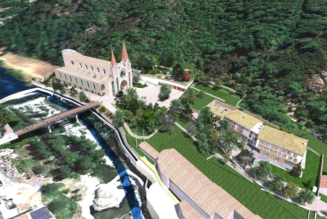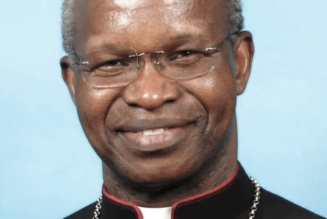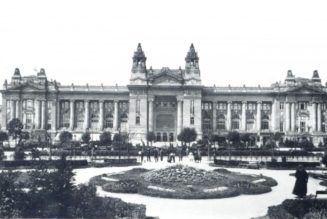In July, the United States held its first National Eucharistic Congress in 83 years — a monumental moment in the life of the local Church. However, it’s not the only Eucharistic congress that’s happening this year.
From Sept. 8 to Sept. 15, the 53rd International Eucharistic Congress will gather thousands of faithful from corners of the world in Quito, Ecuador, to celebrate the Eucharistic presence of Christ in the Most Blessed Sacrament. It marks the first time an Andean country has hosted an international congress and coincides with the 150th anniversary of the consecration of Ecuador to the Sacred Heart of Jesus made in 1874.
The very first international Eucharistic congress was held in France in 1881, and since then, they have occurred every one to five years. The only times that pattern was broken were in the years following World War I and World War II, with a gap of eight years and 14 years, respectively. With several large-scale global conflicts raging today, one can’t help but wonder if this cadence will be broken once more after this year’s international congress.
Even so, the theme for this year’s international congress — “Fraternity to Heal the World” — seems a fitting one to address the widespread strife and divisiveness that seems to grow in the world with each passing day and to strive for unity in Christ. The “Basic Text of the 53rd Congress” states, “Fraternity is a dream that the whole of humanity is experiencing. It is not a utopia, but rather, the opportunity to fulfill the vocation of each person: the call to meet with others. For this reason, in our historical time everyone has the task to explore the theme of fraternity: the depths of Christianity, religions, politics, philosophy and science must be plumbed. Apart from fraternity all can be lost” (21).

The text continues, “The Eucharist offers healing to the world wounded in fraternity. Where sin has caused us to ignore each other as brothers and has placed us in a relationship of opposition and rivalry, the Eucharist calls us to sit at the same table of the Body and Blood of Christ as children of the same Father and, therefore, brothers and sisters of one another.” According to the Pontifical Committee for International Eucharistic Congresses, “The first congresses were inspired by a lively faith in the Real Presence of the Person of Jesus Christ in the sacrament of the Eucharist. As a consequence, Eucharistic worship was expressed particularly in solemn adoration and in grand processions intended to celebrate the triumph of the Eucharist.”
The genesis of the first congress is quite extraordinary in that it was organized not by a member of the clergy but by a laywoman.
Following the French Revolution in the late 18th century, the Church in France was on the decline due to the growing prevalence of secularist policies, and Marie-Marthe-Baptistine Tamisier, under the inspiration of Bishop Louis Gaston de Ségur and with the help of Pope Leo XIII, began to plan an event that would gather people to glorify the “source and summit” of the Christian life.
Tamisier’s idea to hold such a congress was spurred by her encouragement of the French people to make pilgrimages to sites where Eucharistic miracles were commemorated, such as Avignon, Ars, Douai, Paris and Paray-le-Monial. After witnessing 60 members of the French Parliament kneel before the Blessed Sacrament in St. Margaret Mary Alacoque’s chapel at Paray-le-Monial and pledge to resist the secularist policies of the French government, Tamisier was convicted of the power of faith in the Eucharist and realized her dream in 1881.
Indeed, the sociopolitical origins of international Eucharistic congresses still ring true today, as the Church continues to proclaim the Gospel of Jesus Christ in a world that consistently rejects him. Throughout the years, international Eucharistic congresses have served as key moments in the life of the Church, gathering together the mystical body of Christ as one in the Eucharist. They are characterized by large open-air Masses, Eucharistic processions through city streets, robust catechetical sessions and public adoration of the Blessed Sacrament.

The U.S. has hosted two international Eucharistic congresses: 1926 in Chicago and 1976 in Philadelphia. These are not to be confused with the 10 national Eucharistic congresses that have been hosted in the U.S. over the years, including the recent one in Indianapolis. The early congresses were confined to European countries until 1893, when the first congress outside of Europe took place in Jerusalem — a fitting location as the site of the very first Mass in the Upper Room. The congress was attended by hundreds of Latin Rite and Eastern Rite patriarchs, bishops, priests and faithful.
Other notable congresses include: the 19th in 1908, held in London, which marked the first one in the English-speaking world; the 21st, in 1910, held in Montreal, the first one in North America and the Western Hemisphere; the 32nd, in 1932, held in Dublin to coincide with the 1,500th anniversary of St. Patrick’s arrival to Ireland; and the 38th, held in 1964 in Bombay, which was the first time a congress was held in a non-Christian country with the goal of sharing the doctrine of the Real Presence with nonbelievers. This congress was attended by Pope Paul VI, who was joined by many cardinals and 20,000 foreign visitors. The last international congress was held in Budapest, Hungary, in 2021.
Such large-scale public witnesses of faith in the Eucharist have borne much fruit, the most notable of which is continued growth in devotion to the Real Presence. Eucharistic congresses essentially serve one main purpose: to reinforce to the faithful that Our Lord is indeed fully present in the Eucharist.

As many saints, popes and others have noted throughout the Church’s history, it is from this truth that the life of the Church finds its unfettered root. During the 45th International Eucharistic Congress in Seville, Spain, in 1993, Pope St. John Paul II expressed hope that the congress would result in “the establishment of perpetual Eucharistic adoration in all parishes and Christian communities throughout the world.”
Over the last 30 years, it seems as though this hope has come to fruition, with many perpetual adoration chapels continuing to crop up globally.
The Pope’s words from the closing Mass of that congress sum up well the Church’s Eucharistic vision. “From the Eucharistic altar, the pulsating heart of the Church, the evangelizing flow of word and charity is constantly born,” he said. “For this reason, contact with the Eucharist must lead to a greater commitment to make present the redemptive work of Christ in all human realities.”








